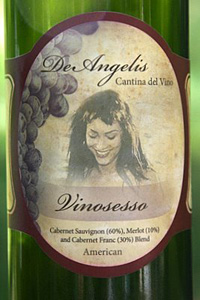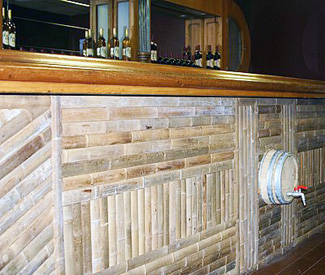Column: Arbor Vinous
In the far corner, wearing synthetic trunks: Steve Heimoff, west coast editor of Wine Enthusiast magazine. I pilfered part of the column title from him; fortunately, Steve’s pretty laid back about such things.
Unlike “natural, schmatural” wine, over which he turns apoplectic: “‘Greenwashing’ is the perfect way to describe a large part of the whole natural, green, sustainable, organic, biodynamic thing. Everybody wants to portray his practices as purer than the other guy’s practices. It’s a holier-than-thou world out there, and IMHO that goes for the whole greenie-natural crowd.”
And here in the near corner, Ann Arborites Stacey and Rob DeAngelis, dressed in the all-natural cloak of DeAngelis Cantina del Vino, whose tasting room opens later this month. It’s the only winery with an Ann Arbor mailing address, though you’ll find it deep in Scio Township.
Not for them, the typical 21st century winemaker’s arsenal of chemicals, sulfites, color enhancers and designer yeasts.
What’s in the wines? “Just the grapes,” says Stacey DeAngelis, whose picture appears on their label.
She’s not kidding.
Rob and Stacey reflect a controversial paradigm shift among a small-but-vocal slice of the wine world. These “natural wine” advocates reject the winemaking techniques of the “international style” associated with the dominant critics and marketers of the last three decades.

The flagship Vinosesso, or "Sexy Wine," with Stacey DeAngelis on the label, has already sold out – before the winery's grand opening. (Photos by the writer.)
What’s the “international style”? Hypothesize a Platonic ideal of wine that lets you judge any wine, made anywhere, with a single set of universal, objective standards.
Best of all, you can plot the results on a 100-point scale.
If you accept that, it’s a short jump to conclude that winemakers carry an obligation to aspire to this ideal, using every tool at their disposal.
“Phooey!” say the naturalists. Where others see Platonic ideals, they see easy-to-drink “industrial” wines with too much ripe fruit and not enough acidity. Worst of all, they say these wines are “manipulated” or “manufactured” according to recipes and formulas to taste a specific way and earn mega-points from the critics.
Natural winemakers produce wines that embrace what their grapes naturally provide, particularly regional character and vintage variations. Their minimal-interventionist winemaking techniques mean they don’t manipulate wines to achieve specific results.
Of course, their wines also reflect any flaws in the grapes, and any mistakes that occur along the way.
If the wine industry is a three-ring circus, then natural winemaking is its high-wire act – without a net. One misstep can bring contamination from the flotsam and jetsam that reside in the ether, awaiting a tasty feast on some vulnerable grapes or wines.
For example, most modern winemakers inoculate crushed grapes with commercial yeast to jump-start fermentation and avoid unwanted microscopic critters accidentally dropping in for a munch. Winemaker Rob DeAngelis waits for the yeast that lives naturally on grape skins to slowly get to work, turning sugar into alcohol.
Most winemakers add sulfites to retard spoilage, and apply liberal blasts of inert nitrogen gas to separate the wine from damaging oxygen. Rob DeAngelis trusts his equipment and overall winery cleanliness to do the job.
And don’t get natural winemakers started about modernistic techniques like reverse osmosis or the addition of Mega Purple, a favorite bête-noir.
Nerves rubbed raw, advocates on both sides have reached a take-no-prisoners level of conversation, reminiscent of what passes for dialogue in the U.S. Congress.
Last week, critic Robert Parker, self-designated spokesman for everything the natural wine movement abhors, body-slammed those who are “saving the world from drinking good wine in the name of vinofreakism.”
Wow. Read that one again. “Vinofreakism.” That’s my kind of an insult.
But the vinofreaks know how to counterpunch the fan base’s soft underbelly. Natural wine importer Joe Dressner – popularizer of the word “spoofulated” to describe highly-manipulated wine – suggests that “the pointists and tasting notes crowd” are misguided souls who “like crappy industrial wines.”
Those would be acolytes of Parker and the Wine Spectator, if you’re keeping score.
In Michigan, Detroit wine guy Putnam Weekley (who puts in occasional Ann Arbor appearances at Everyday Wines) may be the area’s most vocal advocate for natural wine. His “Natural in Detroit” and “Detroit, the Paris of the Midwest” articles for the seriously geeky winesite Saignée have earned him a national audience, among the seriously geeky.
For the record, I’m agnostic on the subject, despite an involuntary cringe last week when I opened a Côtes du Rhône that tasted like someone had worked hard in a misguided attempt to turn it into an Australian Shiraz.
But in general, I figure a wine’s primary obligation is to pleasure the palate. Get that right, and I’ll gladly sit down with you to discuss pedigrees.
That’s why I wangled an invitation from Rob DeAngelis to drop by the nearly complete winery and tasting room, sample what he’ll have for sale later this month, and get his take on natural winemaking.

Rob DeAngelis of DeAngelis Cantina del Vino in Scio Township. He built the winery – and makes the wine.
Rob turns out to be a 50ish, long-haired raffish character in perpetual motion, proprietor of the eponymously-named heating and cooling firm with which the winery co-habits in an industrial building on Jackson Road, west of Baker.
He proudly lays claim to 30 years of experience as an amateur winemaker, following the tradition of his Italian family, but disavows ever reading a book or taking a class on the subject, or entering an amateur wine competition to see how his wines stack up.
“Zero,” he says.
Stacey, the winery’s marketer-in-chief, pounces with spousal glee. “His mother buys him books which he does not read. So she’ll go through and tag all these pages and say, ‘Read this page, read that page.’ But I know for a fact he has never touched them.”
“Nah,” Rob agrees.
But Rob DeAngelis doesn’t lack self-confidence in his coming success as a winemaker, a certitude that takes on new dimensions as we speak.
“I’ve always succeeded at everything I’ve done,” he says. “The winery is going to succeed; failure isn’t an option.”
Rob says that he personally constructed the entire winery and rustic tasting room, which includes a magnificently repurposed wooden bar and stained bamboo paneling.
The tasting room connects to the winery via a long, appropriately-named barrel vault.
To make the winery’s initial releases, all from vintage-2009, DeAngelis purchased grapes grown in California’s Lodi appellation through a Detroit middleman, a decision he now acknowledges got him fruit he calls “second-rate.”
This harvest, Rob and Stacey are doing things differently. They recently returned from a buying trip to California, where they visited growers and contracted to purchase ten varieties of grapes currently ripening on vines in Lodi, Napa and Sonoma. New for 2010 will be a Cabernet Franc, Petite Sirah, and Muscat.
They’re also spending twice as much per ton of grapes as they did in 2009.
“We’re going to get a better grape that I don’t have to worry about,” says Rob. “Because to make it all natural, you want to have all those nutrients inside the grape. This year’s crop is going to blow away last year’s.”
Surprisingly for a natural winemaker, his grapes aren’t organically grown. Rob is convinced that any chemical presence is long-gone by the time the grapes are picked, and his focus on grape quality trumps any concern over how they get there.
“Besides, even if you have an organic vineyard, they still spray next door and it drifts over,” he opines.
But would he consider making wine from commercially-prepared juice or kits? “No juice. Never any juice. You buy juice, you don’t know what they put in it.”
The grapes will show up at the winery in late October or early November, after a three-day voyage east in a refrigerated truck.
“We expect them to arrive right after our opening date, so we’re encouraging people to come by and see how we make wine,” Stacey says.
Ready to receive them: a new crusher and press, and eleven still-to-arrive 1,000-gallon stainless fermentation tanks that will replace the much smaller fermenters used for last year’s trial-run vintage.
Rob won’t age the wine in oak barrels, which he says create a “better chance of getting contamination and bacteria.” Instead, he uses oak staves and bags of oak chips to impart a desired level of flavor to the wine, but ages the wines in the same easy-to-sanitize stainless tanks where they ferment.
“I’ll pressurize and steam-clean them, and I won’t have to worry about bacteria,” he says.
Rob sends his wines out for testing that confirms just three parts per million of naturally occurring sulfites, no sugar, and no yeast. The labels proudly proclaim “No Added Sulfites.”
They did an end-run around the state’s cumbersome licensing legalities by giving a new home to Ypsilanti’s orphaned Frog Island Brewing Company. That business, rechristened U Brew, already had the needed winemaking license and now appears as the winery-of-record on the DeAngelis back labels. Rob, in turn, plans to construct a microbrewery on the other side of the building for U Brew once the winery is complete.
The California buying trip yielded 80 tons of grapes. That’s enough to ferment 10,000 gallons of juice this fall, which should translate into about 4,000 cases of wine. That’s sizable production for a new, unknown Michigan winery.
Neither labeling laws nor existing Michigan practice work to their advantage. Although his 2009 grapes came from California’s Lodi viticultural area, federal law won’t let him put that geographic designation on the front label, because he made the wine in a different state. So the bottles carry only a generic “American” designation.
But that creates a Catch-22: wines without a geographic designation can’t list a vintage date on the label. Their solution: a bottleneck hanger tag identifies the vintage.
Their use of California grapes also means that Cantina del Vino gets no love – or marketing support – from the state’s Grape and Wine Council or southeast Michigan’s Pioneer Wine Trail. Neither of those organizations officially acknowledges the winery on their websites or promotional materials, nor invites them to participate in regional wine events.
So what’s a winemaker to do? For Rob and Stacey, the answer is the same as for Saline’s Spotted Dog Winery: market their own wines at events and directly to retailers.
Fortunately, the all-natural label provides them a strong selling hook; natural wine is a hot commodity in today’s marketplace; they’ve already hired two part-time salespeople in the Detroit area and placed their products in over a dozen retailers. In the Ann Arbor area, DeAngelis wines are available at A&L Wine Castle, South Main Market, and Scio Foods Party Store, as well as Ypsilanti’s Keg Party Store and Ypsilanti Food Coop. Retail prices are in the $16 range.
They just returned from pouring three wines at Detroit Uncorked. Their flagship Bordeaux blend, Vinosesso (“Sexy Wine” in Italian), went into the high-end private tasting.
Rob laughs, “They poured our wine, but they wouldn’t let us in the room to talk about it.”
Fortunately, they didn’t need the sales. Vinosesso’s small production is already sold out, as are the Chardonnay and Pinot Gris.
The winery will open with limited quantities of just four wines, all from the 2009 vintage: Cabernet Sauvignon, Merlot, Shiraz and Zinfandel.
We tasted through nearly every tank in the winery’s production area, which will initially double as their site for private tastings and receptions. Overall, the best description of what I tasted was good, but highly variable, even from tank to tank of the same wine.
That’s not unexpected from natural winemaking’s high-wire act.
One tank of Zinfandel clearly stood out, tasting of fresh, bright red raspberry fruit with some peppery notes. It’s one of the more pleasant Zins to cross my palate this year, particularly if you enjoy the grape’s lighter style.
A couple of other samples were notable for lesser reasons. One small tank of Merlot carried the distinct vinegar taint of acetobacter bacteria, possibly infiltrated from a barrel of Rob’s homemade vinegar that resided for a time just across the room.
Just as it’s unfair to critique a restaurant during opening week, it’s unwise to evaluate a winery based on its first, limited quantity releases. For now, my best guess on DeAngelis Cantina del Vino is “Incomplete.” I’d buy some of the Zinfandel tomorrow, but other wines in the lineup aren’t as ready for commercial prime time.
Rob DeAngelis flaunts the motivation, and possibly the instinctive talent, to make quality wine. Ann Arbor offers a supportive market for a business that makes artisanal, natural products. The winery provides a unique, hospitable venue for parties and events.
But how much will the wines improve across the board? Will this year’s grapes make a big difference? Will Rob adjust his winemaking techniques to avoid the mistakes and high-wire issues that can plague all-natural wines?
Like I said: Incomplete – for now.
DeAngelis Cantina del Vino is at 7879 Jackson Road, west of Baker Road in Scio Township. The winery entrance is on the side of the building, with parking in front and back. They plan to open on Oct. 14, with the official grand opening scheduled Oct. 23. Initial hours are Thursday and Friday, 1-6 p.m., Saturday 11 a.m. to 4 p.m. Phone: 734.564.3260.
About the author: Joel Goldberg, an Ann Arbor area resident, edits the MichWine website and tweets @MichWine. His Arbor Vinous column for The Chronicle is published on the first Saturday of the month.







Fascinating! I’m sure this gutsy enterprise will take time to develop to its full potential. Let’s hope the public is patient!
I’m thinking no, but is there any kind of purity law for wine? I mean similar to the 1516 German Purity Law for beer (hops, water, grain and later yeast)? Is there any kind of regulations for what goes in?
No, there’s no law regulating what natural wine means — and that’s part of the controversy surrounding it. Jon Bonne of the San Francisco Chronicle termed it “fudge-prone and generally a mess” in his excellent column a couple of weeks back: [link]
I’ll take a bottle of the Zin !!!
Great piece, Joel. We’ve missed this kind of detailed reporting! Personally, I’m more a fan of Michigan wine than I am of California fudge, bottled in Michigan. It will be interesting to see where this goes.
Cheers to you!
Terry
Excellent job on a hot topic. The standardization of flavor profiles is an assault on common sense and good taste. We love wine because it is unique, speaks to us of it’s terroir and sings it’s own song. While Mr. Rolland is incredibly talented I don’t want wine from Argentina to taste the same as wine from Bordeaux!
Keep up the good work!
Had a great Vigonier made in Georgia from California grapes. Why not?